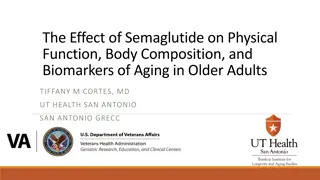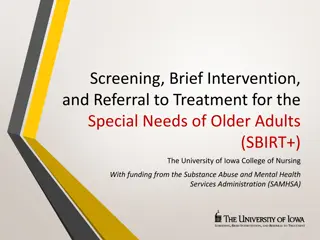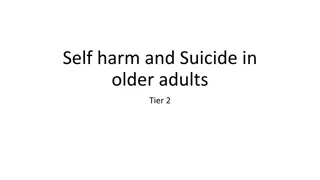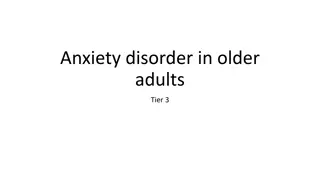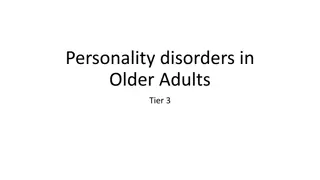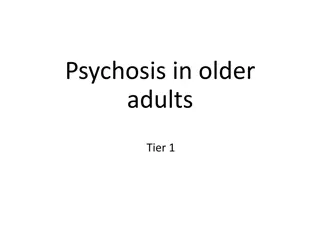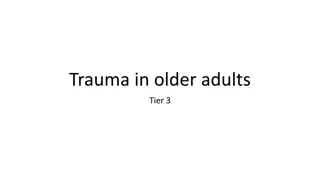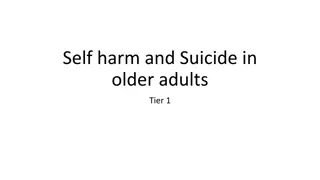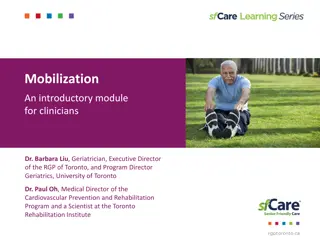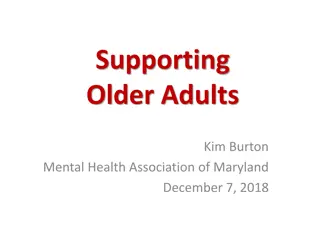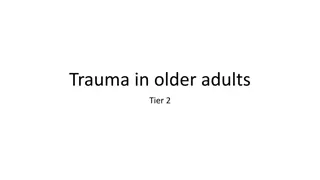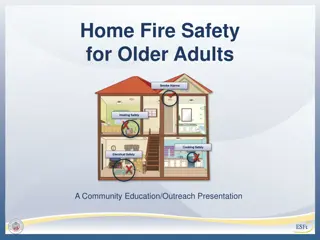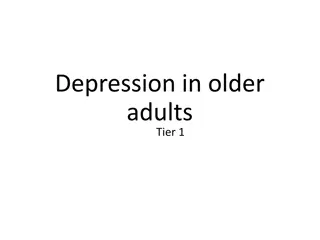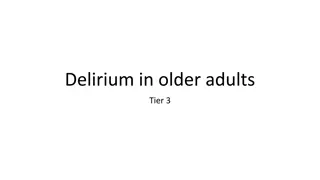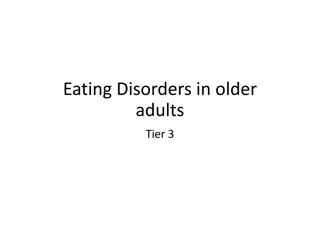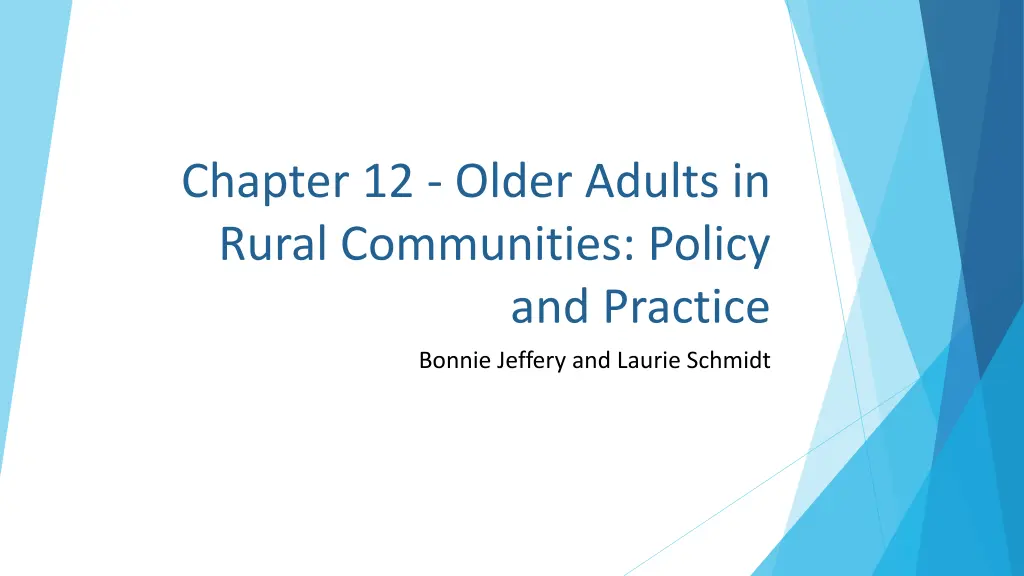
Supporting Successful Aging in Rural Communities: Policy and Practice Insights
Explore the unique challenges and opportunities faced by older adults in rural areas, and learn how social workers can contribute to effective aging-in-place initiatives. Discover the importance of addressing ageism and implementing a social ecological framework for comprehensive support. Gain insights into the increasing aging population in rural regions and the critical role of social work in enhancing the well-being of older adults.
Download Presentation

Please find below an Image/Link to download the presentation.
The content on the website is provided AS IS for your information and personal use only. It may not be sold, licensed, or shared on other websites without obtaining consent from the author. If you encounter any issues during the download, it is possible that the publisher has removed the file from their server.
You are allowed to download the files provided on this website for personal or commercial use, subject to the condition that they are used lawfully. All files are the property of their respective owners.
The content on the website is provided AS IS for your information and personal use only. It may not be sold, licensed, or shared on other websites without obtaining consent from the author.
E N D
Presentation Transcript
Chapter 12 - Older Adults in Rural Communities: Policy and Practice Bonnie Jeffery and Laurie Schmidt
Introduction This chapter will discuss: The unique situation of older adults living in rural communities and the specific role that generalist social workers play at different levels of practice. What rural social workers can do to support successful aging in place for community-dwelling older adults. The concept of ageism which is fundamental to anti- oppressive social work values and practice with this population. The role of a social ecological framework to address the discussion of interventions at micro, mezzo and macro levels of rural social work practice.
Learning Objectives By the end of this chapter you will: Understand the unique context and needs of older adults living in rural areas Understand how an anti-oppressive and social justice approach contributes to a person-centered approach in rural social work with older adults Identify how a social ecological framework that incorporates levels of social work practice supports successful aging for rural older adults
Practice Area and/or the Population of Focus In 2021, 6.6 million Canadians resided in rural areas, an increase of 0.4% from 2016 (Statistics Canada, 2022d). There was a 3.1% increase in the population of residents aged 65 and older in rural areas between 2016 and 2021, while urban areas saw a 1.9% increase in that cohort during that same time period (Statistics Canada, 2022a). In 2021, 79,128 residents in rural Saskatchewan were aged 65 and older, an increase of 10.9% since 2016. This age group now accounts for 20% of the rural population in the province.
Practice Area and/or the Population of Focus An aging population presents numerous opportunities and challenges that need to be managed effectively to ensure the needs of this population are supported, through allocation of resources and implementation of health and social policies. With the growing number of aging adults, particularly in rural communities where resources are limited, it is essential that we understand the specific circumstances that rural communities are facing.
Overview of Policy and Service Delivery Issues Ageism Robert Butler considered ageism to be a form of prejudice by one age group against another, typically expressed by middle- aged adults against youth and older persons. In future work, Butler refined the concept of ageism to be a set of positive or negative attitudes, behaviours, institutional practices, and policies aimed at older adults (Ayalon & Tesch-R mer, 2018). This later definition of ageism is generally what is meant by discussing ageism today, as popular discourse on the topic tends to focus solely on biases against older adults.
Overview of Policy and Service Delivery Issues Ageism At the micro level, ageism is developed and maintained by individuals thoughts, emotions, and beliefs about a particular age group. At the mezzo level, groups, organizations, and other social entities beliefs and actions towards age groups reinforce ageism. Macro-level ageism is created through a culture or society s values towards specific age groups. Each of these levels assists in the production of self-directed and other-directed ageism (Ayalon & Tesch-R mer, 2018).
Overview of Policy and Service Delivery Issues Ageism Given that the values and practice of social work are based on anti-oppressive approaches, it is critical to address ageist attitudes. By focusing on a person-in-environment perspective social workers can address these attitudes at multiple levels of practice.
Overview of Policy and Service Delivery Issues Person-in-Environment Approach to Supporting Rural Older Adults The person-in-environment principle focuses on how a person s environmental context affects their behaviour or self. The environment consists of a person s social, economic, political, communal, historical, religious, physical, cultural and familial context. In order to truly understand a person, one must look at the interplay between an individual and their environment.
3 Levels of Social Work Practice Micro Rural older adults generally experience poorer health in terms of increased mortality, lower life expectancy and functional health, and increased risk of diseases, illness, and injury (Jeffery et al., 2014). Strategies include counselling and consultation, life skills training, healthy relationship building, and educational and awareness programs.
3 Levels of Social Work Practice Mezzo Rural older adults acknowledge that the social interaction while participating in activities with other people is beneficial, many are at increased risk of social isolation and lower social functioning, which is further hindered by the fear of falling and lack of opportunity to interact socially with others in their community (Bacsu et al., 2014; Schmidt et al., 2021). Strategies include initiating programs and interventions that integrate a social component in order to foster increased participation and engagement in health promoting behaviours among rural older adults.
3 Levels of Social Work Practice Macro Challenges for older adults in rural communities include lack of public transportation, inadequate access to specialized health care services, limited housing and home-care and economic barriers related to lower income. Strategies include improving the physical and social environment to create safe places where people live, learn, work, and play by addressing the conditions that impact communities such as poverty, safety, isolation, or access to services. Supporting social policies and advocating for opportunities for rural older adults to remain active and engaged in the community is very important to health and wellness (Novek et al., 2013).
Conclusion Using a social ecological model produces valuable insight into the relationship between individual, social, and environment factors that influence successful aging among rural older adults. Generalist social workers have the professional training and commitment to understand the importance of addressing the issues faced by rural older adults from a social ecological perspective a perspective which highlights the importance of considering all aspects of an individual s environment.
Additional Resources Leader, J., Catherwood, K., & Exner-Pirot, H. (2021). Saskatchewan. In K. Rich, H. Hall & G. Nelson (Eds.), State of rural Canada 2021: Opportunities, recovery and resiliency in changing times (pp. 32-42). Canadian Rural Revitalization Foundation. World Health Organization (2021). Global report on ageism: Executive Summary. World Health Organization
References Ayalon, L., Tesch-R mer, C. (2018). Introduction to the Section: Ageism Concept and Origins. In Ayalon, L., Tesch-R mer, C. (Eds) Contemporary Perspectives on Ageism. Springer Cham. Bacsu, J., Jeffery, B., Abonyi, S., Johnson, S., Novik, N., Martz, D., & Oosman, S. (2014). Healthy aging in place: Perceptions of rural older adults. Educational Gerontology, 40(5), 327-337. Jeffery, B., Bacsu, J., Abonyi, S., Johnson, S., Martz, D., & Novik, N. (2014). Rural Seniors. In: Michalos A.C. (Eds.) Encyclopedia of Quality of Life and Well- Being Research. Springer, Dordrecht. Novek, S., Menec, V., Tran, T., & Bell, S. (2013). Exploring the impacts of senior centres on older adults. Centre on Aging. Retrieved from https://www.gov.mb.ca/seniors/publications/docs/senior_centre_report .pdf
References Statistics Canada. (2022a). In the midst of high job vacancies and historically low unemployment, Canada faces record retirements from an aging labour force: number of seniors aged 65 and older grows six times faster than children 0-14 (no. 11-001-X). https://www150.statcan.gc.ca/n1/en/daily- quotidien/220427/dq220427a-eng.pdf?st=XGF1hDY8. Statistics Canada. (2022d). Population growth in Canada s rural areas, 2016 to 2021 (no. 98-200-X). Schmidt, L., Johnson, S., Genoe, M. R., Jeffery, B & Crawford, J. (2021). Social interaction and physical activity among rural older adults: A scoping review. Journal of Aging and Physical Activity. Pre-print.



